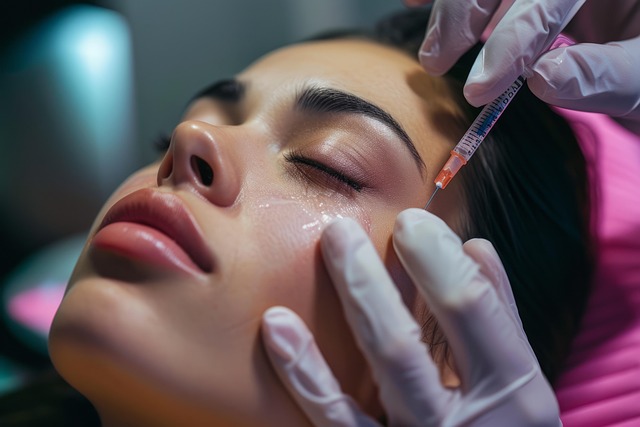Botox for facial contouring, focusing on the jawline, is a non-surgical procedure using Clostridium botulinum to relax muscles beneath the skin. By targeting specific muscle groups, it reshapes facial features naturally, reducing angular jawlines and bulkiness. This minimally invasive treatment offers temporary yet effective results within 2-4 weeks, with follow-up appointments for optimal effectiveness. Safety is crucial; consulting a qualified medical professional is essential due to potential side effects like redness, swelling, and muscle weakness. Consistent care through hydration, gentle skincare, and regular exfoliation maintains long-lasting results.
“Consider a non-surgical solution for jawline shaping—Botox for facial contouring. This innovative approach offers a subtle yet transformative way to enhance facial aesthetics. In this comprehensive guide, we explore how Botox works its magic on the jawline, unveiling its benefits, expected results, and step-by-step procedure. From safety considerations to maintenance tips, learn everything you need to know about Botox for facial contouring, empowering you to make informed decisions for your beauty regimen.”
Understanding Jawline Shaping with Botox: A Non-Surgical Approach

Botox has emerged as a popular, non-surgical option for those seeking to enhance their facial features, particularly when it comes to jawline shaping. This injectable treatment offers a subtle yet effective way to redefine facial contours without incisions or extensive recovery periods. By targeting specific muscles responsible for jawline definition, Botox can help create a more chiseled appearance.
Through careful injection techniques, Botox temporarily paralyzes the masseter and temporalis muscles, which are key players in jaw movement and clenching. This muscle relaxation leads to a reduction in the bulkiness often associated with a stronger jawline. The result is a refined, sculpted look that many find aesthetically pleasing. With its minimal invasiveness and natural-looking outcomes, Botox for facial contouring, specifically jawline shaping, has gained significant popularity among individuals seeking alternative beauty enhancements.
How Botox Works for Facial Contouring

Botox, a protein derived from a bacteria called Clostridium botulinum, is renowned for its ability to smooth out wrinkles and fine lines when injected into specific areas of the skin. However, its applications extend far beyond cosmetic procedures. In the realm of facial contouring, Botox for jawline shaping has emerged as a popular non-surgical option.
When used for facial contouring, Botox works by temporarily paralyzing or weakening certain muscles under the skin’s surface. This action reduces the pull and tension on the overlying skin, leading to a smoothing effect. Specifically, in the case of jawline shaping, Botox injections target the masseter muscles, which are responsible for chewing and can contribute to a squared or angular jawline appearance. By relaxing these muscles, Botox can help soften sharp lines and contours, creating a more refined and oval-shaped jawline. This minimally invasive procedure offers a temporary yet effective solution, allowing individuals to achieve their desired facial symmetry without the need for surgery.
Benefits and Results: What to Expect from Treatment

Botox for facial contouring, particularly targeting the jawline, has gained significant popularity as a non-surgical aesthetic procedure. The primary benefit lies in its ability to subtly redefine facial features by relaxing specific muscle groups responsible for undesirable tension and bulkiness below the skin’s surface. This treatment offers a natural-looking enhancement, addressing concerns such as a square or bulky jawline, double chin, and even neck band.
Upon receiving Botox for jawline shaping, patients can expect visible results that enhance facial balance and harmony. Over time, typically within 2–4 weeks, the treated muscles weaken, leading to a reduction in deep facial lines, including jowls and neck bands. This treatment is ideal for those seeking a more defined jawline without the recovery period associated with surgical procedures. Many individuals appreciate the convenience, minimal downtime, and long-lasting effects of Botox as a non-invasive approach to facial contouring.
The Procedure: Step-by-Step Guide to Jawline Filling

The procedure of using Botox for jawline shaping involves a precise and skilled approach to facial contouring. First, the patient consults with a dermatologist or plastic surgeon who assesses their facial structure and skin condition. If Botox is deemed suitable, the treatment begins with topical numbing to minimize discomfort. The healthcare provider then uses fine needles to inject small amounts of Botox into specific muscle groups along the jawline.
These injections target the masseter and temporalis muscles, responsible for chewing and jaw clenching, respectively. The Botox temporarily paralyses these muscles, reducing their ability to contract and causing a subtle yet defined reshaping of the jawline. This non-surgical procedure is generally quick, taking around 15-30 minutes, and results can be seen within a few days as the muscles relax, offering a more contoured and streamlined jawline appearance that complements facial features.
Safety and Side Effects: Considerations Before Getting Botox

When considering Botox for facial contouring, especially on the jawline, safety should be your top priority. It’s a non-invasive procedure, but it’s not without risks. The most common side effects include temporary redness, swelling, and bruising at the injection sites. Some individuals may also experience headaches, muscle weakness in the treated area, or even difficulty swallowing for a brief period. While these effects are usually mild and subside within a few days, it’s crucial to consult with a qualified medical professional who can assess your unique situation and determine if Botox is suitable for you. They will be able to provide guidance on managing potential side effects and ensure the procedure is performed safely.
Maintenance and Follow-Up Care for Long-Lasting Results

After your initial Botox for facial contouring treatment, maintaining and following up on care is crucial to ensuring long-lasting results. This involves staying hydrated by drinking plenty of water daily, as it helps to keep the skin supple and improves overall texture. Additionally, incorporating a gentle skincare routine into your regimen is essential; use mild cleansers and avoid harsh products that could irritate the treated area. Exfoliating regularly, but not excessively, can help remove dead skin cells while promoting new cell growth.
Regular follow-up appointments with a qualified dermatologist or injector are also vital. They can assess the progress of the treatment, address any concerns, and provide additional injections if necessary to maintain the desired jawline shape. Remember, consistency is key; maintaining proper care and following up as recommended will help extend the effectiveness of your Botox for facial contouring procedure.
